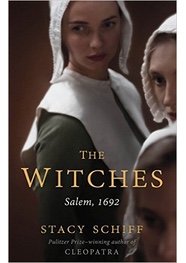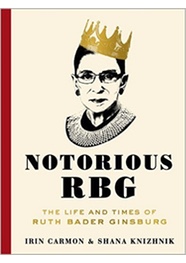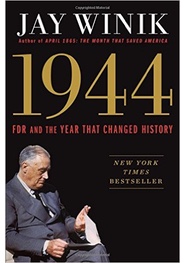NYT History Book Reviews: Who Got Noticed this Week?
Book: The Witches: Salem, 1692
Summary (Via Amazon): "It began in 1692, over an exceptionally raw Massachusetts winter, when a minister's daughter began to scream and convulse. It ended less than a year later, but not before 19 men and women had been hanged and an elderly man crushed to death. The panic spread quickly, involving the most educated men and prominent politicians in the colony. Neighbors accused neighbors, parents and children each other. Aside from suffrage, the Salem Witch Trials represent the only moment when women played the central role in American history. In curious ways, the trials would shape the future republic."
Author: Stacy Schiff
Reviewer: Jane Kamensky is Pforzheimer Foundation director of the Schlesinger Library on the History of Women in America and a professor of history at Harvard.
Schiff was the 2006 winner of the George Washington Book Prize for her book A Great Improvisation: Franklin, France, and the Birth of America. Kamensky was a finalist in 2009 for her book The Exchange Artist: A Tale of High-Flying Speculation and America's First Banking Collapse. The two women also share a spot on the executive board of the Society of American Historians.
Reviewer highlights
"Schiff’s glib, compendious and often maddening account of the events of that fateful year, does a great deal to punch up the story, but little to explore and still less to understand its significance. An acclaimed biographer of subjects as diverse as Cleopatra and Véra Nabokov, Schiff here broadens her lens, like an artist turning from portraits to teeming allegories: Rembrandt taking up the work of Bosch. But a crowded canvas does not a probing history make, as The Witches powerfully demonstrates.
"Those who think of history as a process of detection leading to original interpretation will find little new, and less of interest here.
“Schiff sets scenes brilliantly, evoking the bite of cold so deep that ‘bread froze in communion plates, ink in pens, sap in the fireplace.’ Her prose swelters with the stifling heat of a summer during which the region’s crowded jails grew noisome, and bodies swung, several at a clip, from a gallows hastily erected in a pasture.
“Schiff is what the Germans call a Menschenkenner: a knower of human nature, and her book is a tightly plotted character study.
“For all her talents in sketching the who, what, where and when of the Salem trials, this vexed question of why is one that Schiff simply cannot manage. She makes a collage of previous scholars’ answers.”
Erik Moshe
Comments:
“What a pity every child couldn't learn to read under a willow
tree...”
― Elizabeth
George Speare,
The
Witch of Blackbird Pondand
this.
Book: Notorious RBG: The Life and Times of Ruth Bader Ginsburg
Summary (Via Amazon): "Nearly a half-century into being a feminist and legal pioneer, something funny happened to Supreme Court Justice Ruth Bader Ginsburg: the octogenarian won the internet. Across America, people who weren’t even born when Ginsburg made her name are tattooing themselves with her face, setting her famously searing dissents to music, and making viral videos in tribute. In a class of its own, and much to Ginsburg’s own amusement, is the Notorious RBG Tumblr, which juxtaposes the diminutive but fierce Jewish grandmother with the 350-pound rapper featuring original artwork submitted from around the world.
"Notorious RBG offers a visually rich, intimate, unprecedented look at the Justice and how she changed the world. From Ginsburg’s refusal to let the slammed doors of sexism stop her to her innovative legal work, from her before-its-time feminist marriage to her perch on the nation’s highest court—with the fierce dissents to match—get to know RBG as never before. As the country struggles with the unfinished business of gender equality and civil rights, Ginsburg stands as a testament to how far we can come with a little chutzpah."
Authors: Irin Carmon and Shana Knizhnik. Carmon is an Israeli-American journalist and commentator. She is a national reporter at MSNBC, covering women, politics, and culture for the website and on air. She is a Visiting Fellow in the Program for the Study of Reproductive Justice at Yale Law School.
Knizhnik is a graduate of the NYU School of Law and the curator of Notorious R.B.G. Tumblr, a meme-filled forum for fans of Ginsburg.
Reviewer: Jennifer Senior is the new daily book critic for The New York Times.
Reviewer highlights
"Aesthetically speaking, Notorious RBG: The Life and Times of Ruth Bader Ginsburg is a cheery curio, as if a scrapbook and the Talmud decided to have a baby.
"Notorious RBG may be a playful project, but it asks to be read seriously. It’s an artisanal hagiography, a frank and admiring piece of fan nonfiction.
"This book is also a direct descendant of contemporary feminist websites (Ms. Carmon spent two years as a staff writer at Jezebel) and as such, has not just their strengths — wit, sharp consciousness-raising — but also, on occasion, their weaknesses (a Manichaean worldview, a lack of tonal maturity)."
Erik Moshe Comments: Back in 2005, HNN interviewed Michael J. Klarman, who had been a clerk under Ginsburg at the U.S. Court of Appeals.
Book: London Fog: The Biography
Summary (Via Amazon): "In popular imagination, London is a city of fog. The classic London fogs, the thick yellow ‘pea-soupers,’ were born in the industrial age of the early nineteenth century. The first globally notorious instance of air pollution, they remained a constant feature of cold, windless winter days until clean air legislation in the 1960s brought about their demise. Corton tells the story of these epic London fogs, their dangers and beauty, and their lasting effects on our culture and imagination."
Author: Christine L. Corton is a Cambridge scholar and freelance writer.
Reviewer: Miranda Seymour is an English biographer and novelist who I'm almost sure is familiar with London fog.
Reviewer highlights
"...engrossing and magnificently researched...
"Corton’s book combines meticulous social history with a wealth of eccentric detail.
"Thus we learn that London’s ubiquitous plane trees were chosen for their shiny, fog-resistant foliage. And since Jack the Ripper actually went out to stalk his victims on fog-free nights, filmmakers had to fake the sort of dank, smoke-wreathed London scenes audiences craved. It’s discoveries like these that make reading London Fog such an unusual, enthralling and enlightening experience."
Erik Moshe Comments: As Morpheus in the Matrix might say, "do you think that's air you're breathing?" I haven't the foggiest idea.
Book: The New Tsar: The Rise and Reign of Vladimir Putin
Summary (Via
Amazon):
"The epic tale of the rise to power of Russia's current
president—the only complete biography in English – that fully
captures his emergence from shrouded obscurity and deprivation to
become one of the most consequential and complicated leaders in
modern history.
“Myers recounts Putin’s origins—from his
childhood of abject poverty in Leningrad, to his ascension through
the ranks of the KGB, and his eventual consolidation of rule. Along
the way, world events familiar to readers, such as September 11th and
Russia’s war in Georgia in 2008, as well as the 2014 annexation of
Crimea and the ongoing conflict in Ukraine, are presented from
never-before-seen perspectives."
Author: Steven Lee Myers, who spent several years working as the NYT Moscow bureau chief.
Reviewer:
Gal Beckerman. His first book, “When
They Come for Us, We’ll Be Gone: The Epic Struggle to Save Soviet
Jewry,
” was named a best book of the year by The New Yorker and The
Washington Post. He has written
about Putin before for the WSJ book review.
Reviewer
highlights
"...what Steven Lee Myers gets so right in The New Tsar, his comprehensive new biography — the most informative and extensive so far in English — is that at bottom Putin simply feels that he’s the last one standing between order and chaos. Rather than a unified theory of Putin, what Myers offers is the portrait of a man swinging from crisis to crisis with one goal: projecting strength.
"...a knowledgeable and thorough biography, though one that can feel a bit detached and bogged down by information at times. What’s missing, for example, is a view from the street, an understanding of what Russians feel about their ‘new tsar.’
Erik Moshe Comments: The Surprising Consensus on What Experts Say about Putin
Book: 1944: FDR and the Year That Changed History
Summary (Via Amazon): "1944 witnessed a series of titanic events: FDR at the pinnacle of his wartime leadership as well as his reelection, the planning of Operation Overlord with Churchill and Stalin, the unprecedented D-Day invasion, the liberation of Paris and the horrific Battle of the Bulge, and the tumultuous conferences that finally shaped the coming peace. But on the way, millions of more lives were still at stake as President Roosevelt was exposed to mounting evidence of the most grotesque crime in history, the Final Solution.
“Just as the Allies were landing in Normandy, the Nazis were accelerating the killing of millions of European Jews. Winik shows how escalating pressures fell on an all but dying Roosevelt, whose rapidly deteriorating health was a closely guarded secret. Here then, as with D-Day, was a momentous decision for the president. Was winning the war the best way to rescue the Jews? Was a rescue even possible? Or would it get in the way of defeating Hitler? In a year when even the most audacious undertakings were within the world’s reach, including the liberation of Europe, one challenge—saving Europe’s Jews—seemed to remain beyond Roosevelt’s grasp."
Author: Jay Winik is an American historian.
Reviewer: Lynne Olson’s latest book is “Those Angry Days: Roosevelt, Lindbergh, and America’s Fight Over World War II, 1939-1941.”
Reviewer highlights
"In 1944: FDR and the Year That Changed History, Winik has turned his attention to another president, war and pivotal moment. This time, his thesis is more difficult to decipher and less persuasive. Reading 1944, I was reminded of ‘Where’s Waldo?,’ the classic picture book series whose brightly colored illustrations challenge young readers to find the title character, hidden in huge crowds. Similarly, the key points in 1944 are surrounded by vast amounts of information about Franklin Roosevelt and World War II, much of it irrelevant to the main story."
Erik Moshe Comments: HNN interviewed Lynne Olson back in 2013 in an article entitled "America's Fierce Quarrel over Entry into World War II.”
For Fun: If You Want To Understand Putin, You Have To Know These 15 Facts




